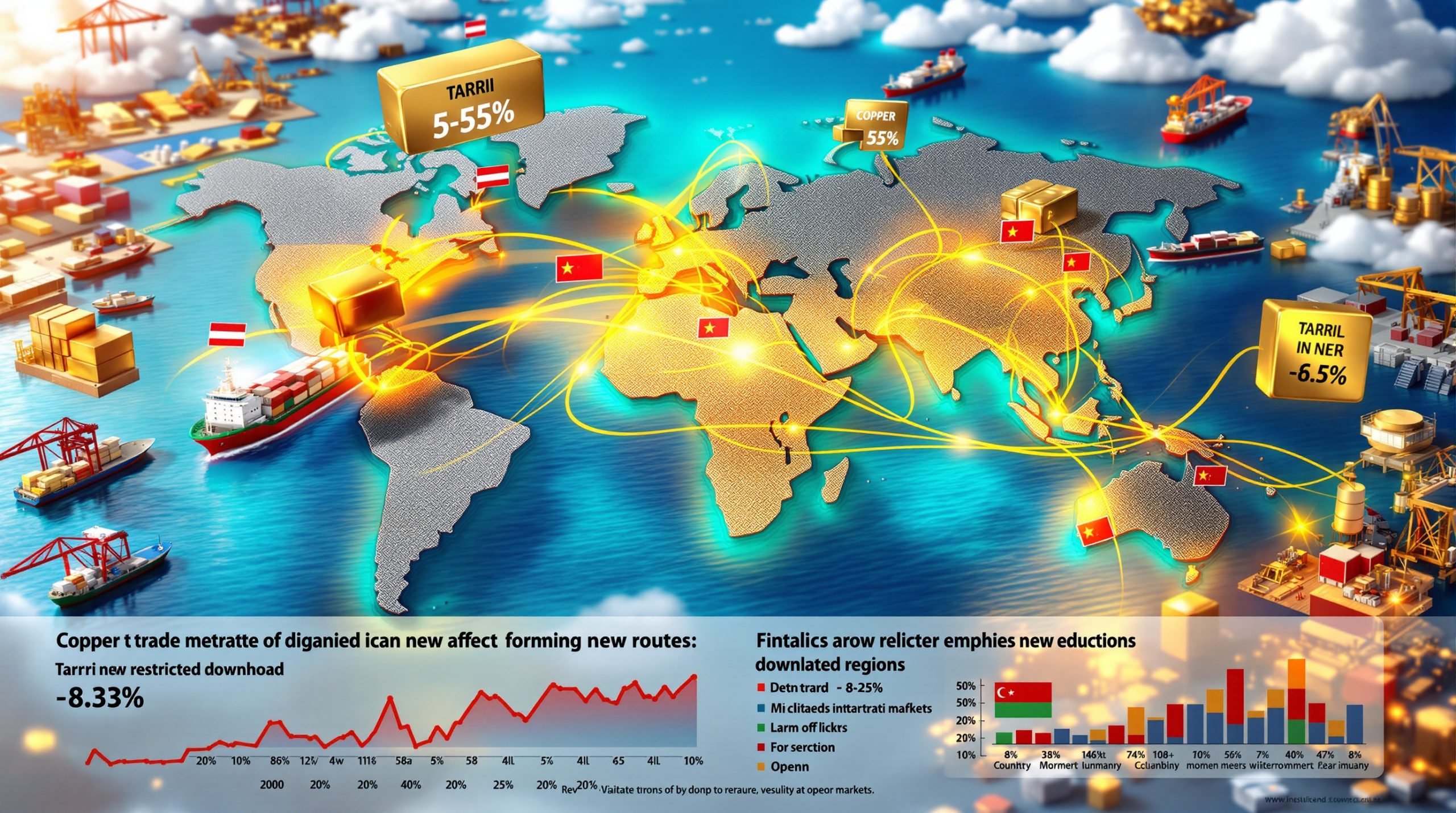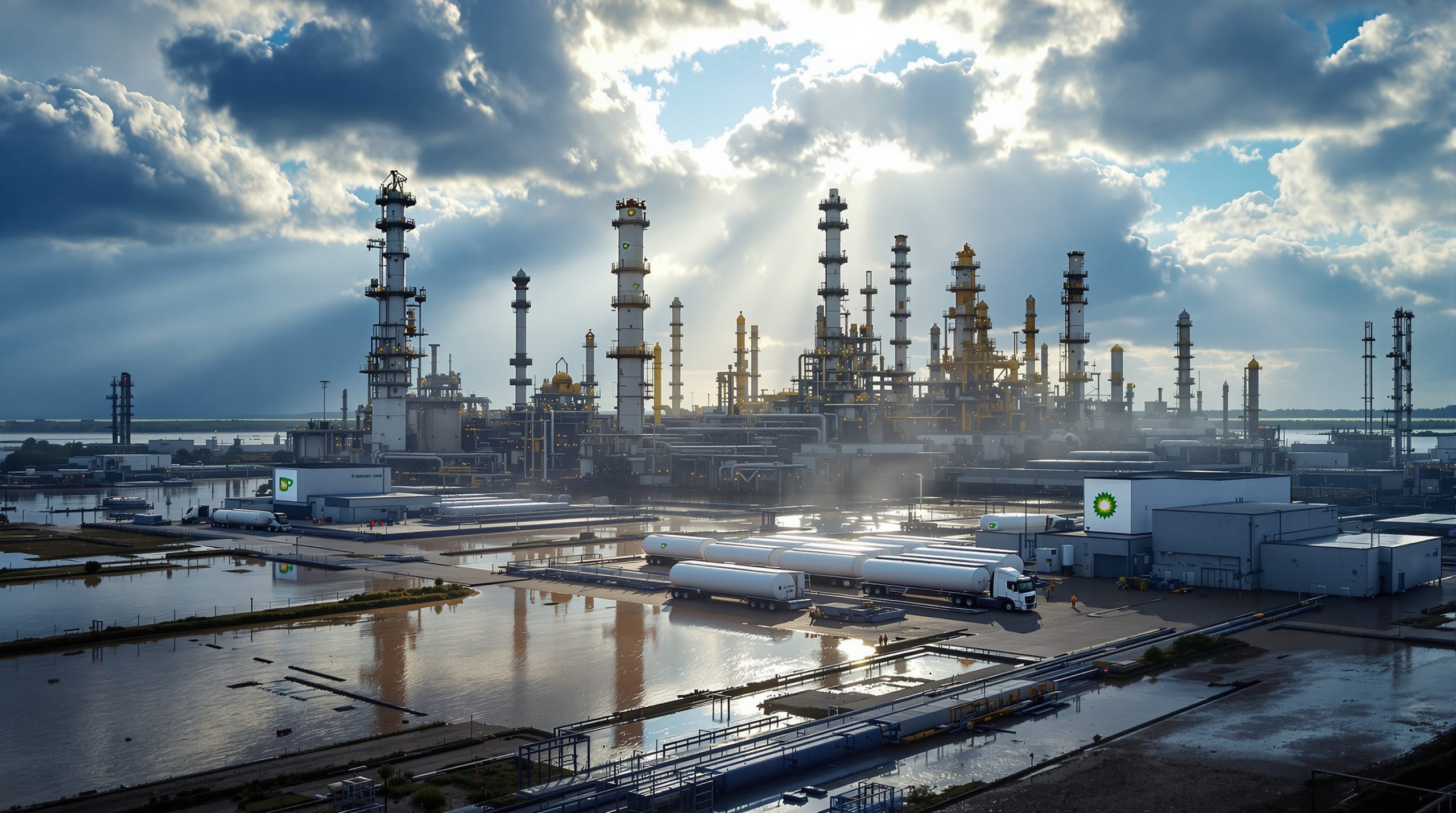How Are Global Tariffs Reshaping the Metals Market?
The global metals industry is experiencing unprecedented shifts as trade policies reshape the flow of critical minerals across borders. Recent data indicates significant market disruptions, with metal shipments decreasing by 8.3% in regions affected by new tariff implementations over the past year. This restructuring is creating ripple effects throughout supply chains worldwide.
Tariff rates on major metals like copper, iron ore, and nickel currently range from 5-25%, varying by country and processing level. The disparities have triggered a remarkable redirection of trade flows, with approximately 15% of copper shipments finding alternative destinations to avoid prohibitive tariffs.
"The metals industry is experiencing a fundamental restructuring of trade flows," notes Mike Henry, CEO of BHP, one of the world's largest mining companies. "We're seeing unprecedented shifts in traditional shipping routes as companies adapt to new economic realities."
The Evolving Landscape of Metal Trade Restrictions
Metal trade restrictions have evolved from simple revenue-generating mechanisms to sophisticated tools of economic and geopolitical strategy. Countries increasingly use targeted tariffs to protect domestic industries, secure critical mineral supply chains, and advance broader policy objectives.
The impact varies significantly by metal type and processing stage:
- Raw materials typically face lower tariff rates (5-10%)
- Semi-finished products encounter moderate barriers (10-15%)
- Finished metal products experience the highest tariffs (15-25%)
This graduated approach incentivizes domestic processing, creating significant challenges for mining companies that primarily export raw materials.
Key Metals Affected by Recent Tariff Policies
Copper stands at the forefront of metal tariff disputes, facing duties up to 25% in some markets. As an essential component in renewable energy infrastructure, electronics, and construction, these tariffs have particular significance for ASX copper tariff impact and global energy transition efforts.
Iron ore and steel products encounter a complex web of tariff structures. Countries with developing steel industries often implement protective measures, while major exporters push for reduced barriers. This tension creates ongoing trade friction and policy uncertainty.
Critical minerals essential for the energy transition—including lithium, cobalt, and rare earth elements—increasingly face strategic trade barriers. Governments recognize these minerals' strategic importance, implementing policies that prioritize domestic supply chain development over free trade principles.
What Are the Economic Implications of Metal Tariffs?
The economic consequences of metal tariffs extend throughout global supply chains, creating both challenges and opportunities for industry participants. Price distortions, supply disruptions, and strategic repositioning have become defining features of the metal trade landscape.
Price Volatility and Supply Chain Disruptions
Metal price premiums of 12-18% have emerged in markets with high tariff barriers, creating significant regional price disparities. These differences, while challenging for end-users, present arbitrage opportunities for sophisticated metal traders despite higher logistics costs.
The financial impact extends beyond direct tariff costs:
- Supply chain reconfiguration expenses estimated at $3.2 billion industry-wide
- Delivery timeline extensions averaging 22-30 days for cross-border shipments
- Inventory management complications resulting in 35% higher holding costs
"When tariffs disrupt established supply chains, the costs go far beyond the tariff itself," explains an industry analyst. "Companies face complex decisions about inventory placement, transportation routes, and production locations."
Industry-Specific Financial Impact
The financial strain of tariff policies affects different segments of the metals industry in distinct ways. Mining companies report 5-7% margin compression due to US tariff effects, while downstream manufacturers absorb approximately $1.8 billion in additional input costs annually.
Metal traders have developed new business models focused on tariff optimization strategies, including:
- Strategic inventory positioning across multiple jurisdictions
- Development of specialized logistics solutions
- Creation of sophisticated trade financing structures
- Investment in advanced classification systems to minimize tariff exposure
This adaptation, while necessary, introduces additional complexity and cost into metals supply chains.
How Are Mining Companies Adapting Their Operations?
Faced with an increasingly fragmented global trade landscape, mining companies are implementing strategic operational changes to maintain market access and preserve margins.
Strategic Responses to Trade Barriers
Leading mining corporations have adopted multi-faceted approaches to navigate the complex tariff environment:
- Geographic diversification of customer bases across multiple jurisdictions
- Downstream integration through investment in processing facilities to ship higher-value products
- Strategic partnerships with customers and suppliers to create aligned interests
- Flexible production scheduling to respond rapidly to market disruptions
These strategies require significant capital investment and organizational agility, favoring larger players with diversified asset portfolios.
Case Study: Major Mining Conglomerate Strategies
Major mining conglomerates are implementing sophisticated tariff mitigation strategies. Operational adjustments include production shifts between global assets, allowing companies to optimize output based on changing tariff structures.
Supply chain redesign efforts focus on building resilience against trade policy changes, with contingency planning for various tariff escalation scenarios becoming standard practice. Companies also actively explore vertical integration opportunities, acquiring or developing processing facilities in strategic locations to minimize tariff exposure.
"In today's environment, a mining company's ability to navigate geopolitical complexity is as important as its operational excellence," notes an industry executive. "The winners will be those who can adapt quickly to changing trade policies while maintaining cost discipline."
Which Countries Are Leading the Tariff Implementation?
The global tariff landscape reflects complex national interests, with both developed and developing economies implementing protective measures for different strategic reasons.
Current Global Tariff Landscape
Major economies have implemented protective measures for domestic metal industries, citing national security concerns, employment protection, and industrial policy objectives. These measures range from traditional tariffs to more sophisticated non-tariff barriers based on environmental or technical standards.
Developing nations increasingly utilize tariffs to encourage local processing and value addition, seeking to capture more of the economic benefit from their natural resources. This approach represents a departure from historical patterns where developing countries primarily exported raw materials.
Regional trade blocs have created preferential systems for member states, establishing competitive advantages for intra-bloc trade while creating new barriers for external partners. This regionalization trend has accelerated disputes at the World Trade Organization, with metal-related complaints increasing by 40% in recent years.
Geopolitical Drivers Behind Metal Tariffs
Resource nationalism has emerged as a key factor in policy decisions, with countries viewing control over critical mineral supply chains as a strategic imperative. This perspective has intensified as the energy transition increases demand for specialized metals.
Environmental standards increasingly function as non-tariff barriers, with countries implementing carbon border adjustment mechanisms that effectively serve as tariffs on metals produced in regions with less stringent environmental regulations.
Political considerations significantly affect trade relationship stability, with bilateral tensions often manifesting first in metal trade restrictions before expanding to other sectors. The US-China trade war effects have been particularly influential in reshaping global metal shipment patterns.
What Are the Long-Term Market Implications?
The current tariff environment is driving structural changes in global metal markets that will persist even if specific policies change, creating lasting implications for industry participants.
Structural Changes in Global Metal Trade
The regionalization of metal supply chains is accelerating at approximately 28% annually, reversing decades of globalization in the sector. Companies increasingly prioritize shorter, more secure supply chains over purely cost-based optimization.
Investment patterns have shifted toward tariff-neutral jurisdictions, with processing capacity expanding in countries with favorable trade agreements. This reallocation of capital creates winners and losers, with some previously marginal mining regions gaining newfound competitiveness.
Market share redistribution among major producers based on tariff exposure has begun, with companies possessing diversified asset portfolios gaining advantage over single-jurisdiction operators.
Future Outlook for Metal Shipments
Industry analysts predict a 12% increase in shipping costs for metal products over the next 24 months as trade routes lengthen and become more complex. This cost pressure will likely accelerate technology adoption focused on logistics optimization and trade compliance automation.
Specialized trade finance solutions for tariff-affected transactions are emerging, helping companies manage the increased working capital requirements associated with longer, more complex supply chains. These innovations include tariff-specific insurance products and flexible payment terms.
Advanced forecasting models incorporating trade policy variables have become essential tools for metal market participants, with companies investing heavily in policy intelligence capabilities to anticipate tariff changes.
How Can Companies Navigate Tariff Complexities?
Successfully navigating the complex tariff landscape requires sophisticated planning and operational flexibility, creating both challenges and opportunities for industry participants.
Strategic Planning for Tariff Uncertainty
Scenario-based planning incorporating multiple tariff trajectories has become standard practice for forward-thinking metal producers and consumers. This approach requires:
- Regular review of trade policy developments across key markets
- Development of flexible commercial terms to address tariff fluctuations
- Investment in trade compliance expertise and systems
- Creation of decision frameworks that can quickly respond to policy changes
Companies that excel in this environment maintain options across multiple jurisdictions, allowing them to quickly pivot as conditions change.
Best Practices for Tariff Management
Leading companies have implemented comprehensive tariff management strategies:
- Origin tracking and documentation: Detailed systems to verify and document material origin throughout the supply chain
- Strategic inventory positioning: Placement of material in free trade zones and bonded warehouses to defer or minimize tariff exposure
- Classification optimization: Implementation of advanced classification systems to ensure products receive the most favorable tariff treatment
- Compliance automation: Investment in technology solutions that monitor regulatory changes and flag compliance issues
These practices help companies minimize tariff costs while ensuring regulatory compliance across complex global operations.
What Are the Environmental Implications of Changing Trade Patterns?
The reshaping of metal trade flows carries significant environmental implications, creating new sustainability challenges and opportunities.
Sustainability Impact of Tariff-Driven Changes
Carbon footprint increases of 18-22% have been observed due to longer shipping routes and suboptimal production locations. This environmental cost often goes unaccounted for in tariff policy discussions, creating tension between trade and climate objectives.
Localized environmental pressures have intensified in regions with expanded production, particularly when rapid capacity growth outpaces regulatory oversight. This challenge is especially acute in developing regions that may have less robust environmental protection frameworks.
Regulatory compliance across multiple jurisdictions has become increasingly complex, with companies navigating different standards for emissions, water usage, and waste management. This complexity adds cost and risk to metal supply chains.
Balancing Trade Protection and Climate Goals
Carbon border adjustment mechanisms increasingly intersect with traditional tariffs, creating a complex regulatory landscape where climate and trade policies sometimes conflict. Companies must navigate these overlapping systems while maintaining competitiveness.
Sustainability certification is becoming a factor in tariff determination, with preferential treatment sometimes available for metals produced according to recognized environmental standards. This trend creates incentives for improved practices but adds another layer of compliance complexity.
International coordination efforts on harmonizing environmental and trade policies are gaining momentum, though progress remains uneven. Industry leaders advocate for predictable, consistent approaches that allow for effective planning and investment, according to Maersk's latest analysis on global tariffs.
FAQ: Global Tariffs and Metal Markets
How do tariffs specifically affect copper shipments?
Copper shipments face particular challenges due to their essential role in infrastructure and technology manufacturing. Current tariffs range from 10-25% in major markets, resulting in rerouting of approximately 15% of global copper trade flows. Companies respond by establishing processing facilities in tariff-advantaged locations and developing strategic stockpiles to buffer against policy changes.
The impact extends beyond direct costs, affecting delivery timing and reliability. Manufacturers dependent on copper inputs report significant challenges in production planning, with some implementing "tariff adders" in customer contracts to share the risk of future policy changes.
What strategies are most effective for mining companies facing tariff barriers?
The most successful approaches for mining companies include:
- Diversifying market exposure across multiple jurisdictions
- Investing in downstream processing to ship higher-value products with different tariff classifications
- Developing flexible production capabilities to respond to market disruptions
- Forming strategic partnerships with customers in key markets to create mutual interest in tariff resolution
Companies with globally distributed assets hold significant advantages, as they can shift production emphasis based on evolving tariff structures.
How are tariffs affecting investment decisions in the metals sector?
Investment patterns show a 22% shift toward tariff-neutral jurisdictions and projects with built-in trade flexibility. Capital expenditure decisions increasingly incorporate tariff risk assessments, with companies requiring higher return thresholds for projects with significant tariff exposure.
Joint ventures have become more common as a way to share tariff-related risks, particularly for projects requiring large capital investments. These partnerships often include both upstream producers and downstream consumers, creating aligned interests across the value chain.
The uncertainty has extended project timelines, with companies conducting more extensive policy analysis before making final investment decisions. This cautious approach has contributed to concerns about future supply adequacy for critical minerals.
What role do trade agreements play in mitigating tariff impacts?
Preferential trade agreements provide significant advantages, with metal shipments between agreement partners experiencing 35% higher growth rates compared to non-agreement trade routes. Companies strategically locate operations to maximize benefits from existing agreements while actively engaging in advocacy for new agreements in key markets.
Free trade zones offer particular advantages for metals trading, allowing companies to defer tariff payments until products enter domestic markets. This flexibility provides significant working capital benefits and allows for more efficient inventory management.
Companies increasingly factor existing and potential trade agreements into long-term investment decisions, creating competitive advantages for jurisdictions with extensive agreement networks.
Environmental Considerations in the Tariff Landscape
The environmental impact of tariff-driven changes in metal shipments deserves special consideration. Longer, more complex supply chains increase carbon emissions, while the fragmentation of production can complicate sustainability initiatives.
Forward-thinking companies are implementing comprehensive sustainability strategies that address these challenges, incorporating carbon accounting into logistics decisions and developing innovative solutions to minimize environmental impacts while navigating tariff complexities.
The intersection of climate policy and trade policy will likely become increasingly important, with carbon border adjustment mechanisms effectively functioning as tariffs on metals produced in regions with less stringent environmental regulations. This trend creates both challenges and opportunities for producers committed to sustainable practices.
The global tariff impact on metal shipments has created particular challenges for certain regions, with US tariffs on Canadian industries and tariffs and investment markets demonstrating how these policies reshape international trade relationships in complex and often unexpected ways.
Looking for an Edge in ASX Mining Investments?
Discover significant mineral opportunities before the market moves with Discovery Alert's proprietary Discovery IQ model, which transforms complex geological data into actionable investment insights. Explore why major mineral discoveries can lead to exceptional returns by visiting the dedicated discoveries page and position yourself ahead of the market with a 30-day free trial.




